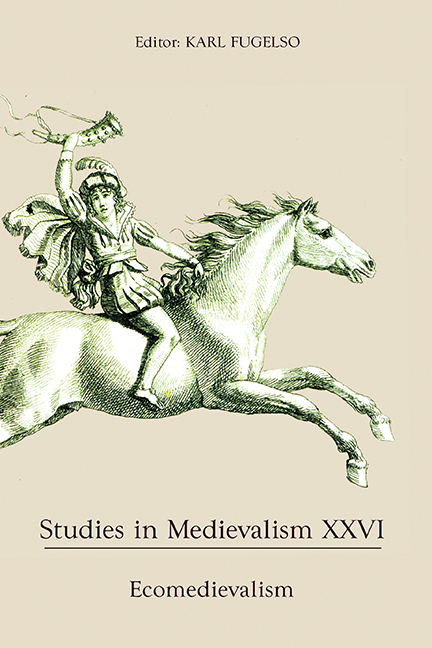Book contents
- Frontmatter
- Studies in Medievalism
- Acknowledgments
- Contents
- List of Illustrations
- Editorial Note
- I Ecomedievalism: Some Perspective(s)
- II Interpretations
- Fragmentary Dreams: John Aubrey's Medieval Heritage Construction
- Charter Horns and the Antiquarian Imagination in Early Modern England
- Giving Voice to Griselda: Radical Reimaginings of a Medieval Tale
- Medieval and Futuristic Hells: The Influence of Dante on Ellison's “I Have No Mouth and I Must Scream”
- Reading Westeros: George R. R. Martin's Multi-Layered Medievalisms
- Modernity in the Middle: The Medieval Fantasy of (Coopted) Feminism in Disney's Maleficent
- Future Medieval: (Neo)Medievalism in Babylon 5 and Crusade
- Cosmopolitan Anxieties and National Identity in the Netflix Marco Polo
- Mapping Everealm: Space, Time, and Medieval Fictions in The Quest
- Medievalisms of the Mind: Undergraduate Perceptions of the “Medieval” and the “Middle Ages”
- Mask of the Medieval Corpse: Prosopopoeia and Corpsepaint in Mayhem's De Mysteriis Dom Sathanas
- Contributors
- Miscellaneous Endmatter
Charter Horns and the Antiquarian Imagination in Early Modern England
from II - Interpretations
Published online by Cambridge University Press: 15 September 2017
- Frontmatter
- Studies in Medievalism
- Acknowledgments
- Contents
- List of Illustrations
- Editorial Note
- I Ecomedievalism: Some Perspective(s)
- II Interpretations
- Fragmentary Dreams: John Aubrey's Medieval Heritage Construction
- Charter Horns and the Antiquarian Imagination in Early Modern England
- Giving Voice to Griselda: Radical Reimaginings of a Medieval Tale
- Medieval and Futuristic Hells: The Influence of Dante on Ellison's “I Have No Mouth and I Must Scream”
- Reading Westeros: George R. R. Martin's Multi-Layered Medievalisms
- Modernity in the Middle: The Medieval Fantasy of (Coopted) Feminism in Disney's Maleficent
- Future Medieval: (Neo)Medievalism in Babylon 5 and Crusade
- Cosmopolitan Anxieties and National Identity in the Netflix Marco Polo
- Mapping Everealm: Space, Time, and Medieval Fictions in The Quest
- Medievalisms of the Mind: Undergraduate Perceptions of the “Medieval” and the “Middle Ages”
- Mask of the Medieval Corpse: Prosopopoeia and Corpsepaint in Mayhem's De Mysteriis Dom Sathanas
- Contributors
- Miscellaneous Endmatter
Summary
On Thursday, 20 February 1755, William Stukeley presented “An Historical Dissertation upon the antient Danish Horn, kept in the Cathedral Church of York” to the Society of Antiquaries of London. The essay was probably familiar to some of the older Fellows, having been read to the Society in 1718 by its author, Samuel Gale. Its subject was the Horn of Ulf, then on display in the sacristy of York Minster. According to Gale, “of all the curiosities which a traveller sees, in visiting the great church of York, nothing can more merit the sedulous notice of the Antiquary, than that large vessel of ivory.”
Stukeley's 1755 rereading of Gale's essay sparked renewed interest in charter horns among English medievalist antiquaries. The “Dissertation” was deemed interesting enough to be included in the first issue of Archaeologia in 1770. The third issue, printed in 1775, opens with a further seven articles on horns ranging from a drinking horn from Corpus Christi College, Cambridge, to a pair of mammoth tusks at Carlisle Cathedral, which Charles Lyttelton partly confused with a hunting horn known to have been given to the cathedral by Henry I. For the rest of the century, references to charter horns continued to appear in the Society's minute books, in periodicals such as Archaeologia, and in a series of popular prints sold to historically minded collectors. According to two modern historians, both before and after Gale “a constant trickle of curious tourists” were “gratified by the sight of Ulphus's horn,” from Celia Fiennes and Daniel Defoe in the seventeenth century to the Duke of York in 1766. This particular antiquarian curiosity was also a notable tourist attraction.
Mostly uninscribed, and almost entirely without accompanying documentary evidence that is contemporary or near contemporary with their creation, charter horns have been largely forgotten by academic medievalists. The wealth of family tradition and local lore that surround charter horns – which made them so appealing to early modern antiquaries – seems to have had almost the opposite effect on twentieth- and twenty-first- century scholars.
- Type
- Chapter
- Information
- Studies in Medievalism XXVIEcomedievalism, pp. 67 - 86Publisher: Boydell & BrewerPrint publication year: 2017

